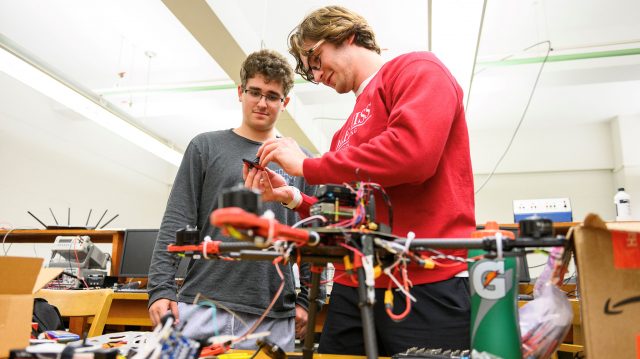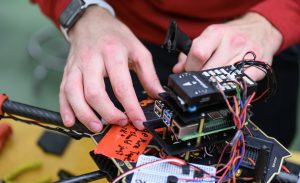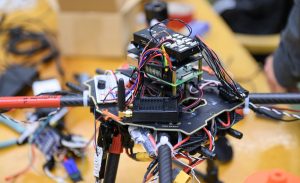
Engineering students William Strojny (left) and Campbell Vaughn work on a drone they built for the Raytheon Unmanned Aircraft Systems University Innovation Showcase. The team is traveling to Texas for the competition, set for Saturday (April 15). Photo by Thomas Graning/Ole Miss Digital Imaging Services
OXFORD, Miss. – A team of students from the University of Mississippi‘s School of Engineering will compete Saturday (April 15) against peers from across the South in an autonomous drone competition.
The Raytheon Unmanned Aircraft Systems University Innovation Showcase asks competitors to research, develop, integrate and test UAS hardware and software components to solve real-world problems.
Ole Miss students will face off against seven other colleges and universities, including Jackson State University, in the competition’s South Region Showcase at the University of Texas at Arlington.
“This type of event really engages our students,” said Darin Van Pelt, UM director of engineering engagement. “They work together to develop the drone across departments with guidance from faculty and a Raytheon mentor.

Campbell Vaughn, a senior engineering major, works on a drone built for a competition sponsored by Raytheon Co. The drone also is part of Vaughn’s senior project. Photo by Thomas Graning/Ole Miss Digital Imaging Services
“It’s hard to get this type of experience in the classroom. The project requires the teams to understand the requirements in order to be competitive and might even generate student-created intellectual property that future partnership opportunities with Raytheon can be built on.”
The team consists of computer and electrical engineering seniors Campbell Vaughn, of Eupora; William Strojny, of Mount Pleasant, South Carolina; and Zihan Wang, of Beijing; and computer and information science seniors Robert Hughes, of Ocean Springs; Brannan Kovachev, of Oxford; Bunrath Leang, of Southaven; and Kentson Tran, of West Helena, Arkansas.
Since the fall, they have created and merged hardware and software for an unmanned aerial vehicle and unmanned ground vehicle to be used in the competition.
Mustafa Matalgah, professor of electrical and computer engineering and general engineering, has advised the students as they designed and built a complete working hardware system. He said the competition is truly unique in the hands-on experience that it provides.
“In addition to technical engineering skills, students learn collaboration and teamwork skills, as well as written and oral communication skills that apply to a wide range of audiences,” Matalgah said.
“This experience exposes our students to successful demonstrations of the final product in a real-world scenario and prepares them to be ready to work in an industry environment.”
Charles Walter, assistant professor of computer and information science, has worked with the students who are writing programming code to operate the drone. He is cautiously optimistic about the software’s performance.

Ole Miss engineering students created and merged hardware and software for an unmanned aerial vehicle and unmanned ground vehicle to be used in the competition. Photo by Thomas Graning/Ole Miss Digital Imaging Services
“We’ve done initial testing and simulated every challenge in the competition,” Walter said. “Assuming our simulation is accurate, we’re doing really well – almost too well, which is a good problem to have.”
This year’s challenges involve scenarios where both types of vehicles are teamed against each other. An unmanned aerial vehicle, or “seeker,” from each school will attempt to seek, identify and disable multiple unmanned ground vehicles, or “evaders,” from other schools.
Vaughn is the electrical engineering student team lead. He assigns tasks to his fellow teammates and serves as the main liaison between the students, advisers and Raytheon representatives.
“My main contributions toward the project are designing the 3D mounts for our parts, creating wiring diagrams and setting up and integrating software onto the drone computer to prepare it for the different competition showcases,” Vaughn said.
“This experience has given me the opportunity to network with employers in my industry and develop my problem-solving skills. I am certain that working on this project will make me stand out to employers.
“As challenging as these past few weeks have been, I would not trade this experience for anything.”
This material is based upon work supported by Raytheon Co.